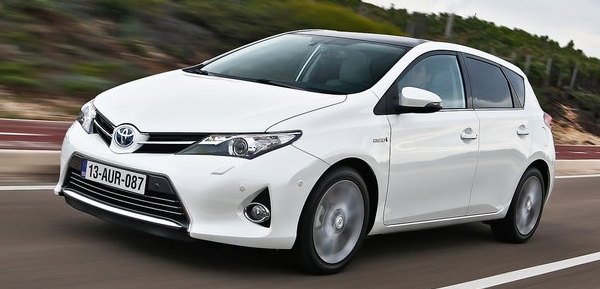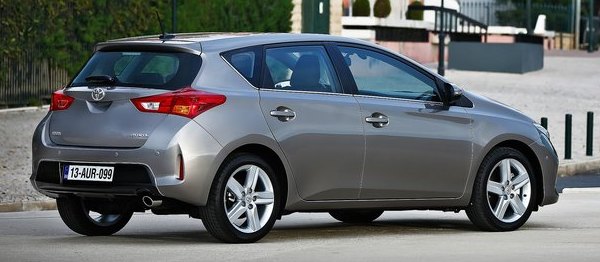|
|
|
Published
on 7
Jan 2013
|
All rights reserved.
|
|

|
The launch of the
second generation Auris reminds us that Toyota is not always
successful. In the last 6 years, only 418,000 units of the Auris have
been sold in Europe. This number is less than one year's sale of its
key rivals like Golf and Focus. In Japan, its domestic version Blade
also failed to register big sales numbers throughout the years. For the
second generation, Toyota decided to discard the Blade nameplate and
calls the car Auris across the world.
The new Auris looks sleeker and more stylish than the Mk1. Its
bullet-train-style front end reduces drag coefficient from the outgoing
car's 0.292 to 0.277. Furthermore, the new car is not as tall as the
old one (1460 mm vs 1515 mm) thus its frontal area is reduced by 4
percent. Overall, this should mean it consumes 9 percent less power to
travel at the same speed as the old car.
Another important improvement is weight reduction. Toyota claims it
shed 40 kg from kerb weight thanks to improved bracings and the use of
more high-strength steel. It is difficult to verify from our kerb
weight figures as Toyota now claims a range instead of an exact figure
for each model. But the reduction does feel present in the way the car
drives. Besides, the new structure and steel materials improve its
rigidity and NVH suppression, which is also evident on the road.

|
However, the platform itself is not new. It is adapted from the old
platform. As before, the lower power models employ torsion beam as rear
suspension. Higher power ones use double-wishbone setup, something
unusual in the segment which favours either torsion-beam or multi-link.
History tells us Toyota has been using such an arrangement for many
years on its 4WD versions of compact cars, so it is probably a cheap
carryover. Anyway, handling should be improved by the lower center of
gravity, which is contributed by the lowered roof, 10 mm lower ride
height and 40 mm lower mounted seats. Ride quality is improved, too, as
the lower center of gravity allows softer suspension setting to be
employed. On the road, the new Auris rides and controls its body motion
pleasantly. Toyota also spent some time to retune its electric power
steering, making it more accurate and linearly weighted, if still too
light for the taste of keen drivers. Nevertheless, the car still can't
quite match the composed ride and sharp handling of the best C-segment
hatchbacks like Volkswagen Golf VII and Ford Focus.
In Japan, the Auris is offered with either 108 hp 1.5 VVT-i or 144 hp
1.8 Dual-VVT-i engine, or in the case of Auris Hybrid a 1.8
Atkinson-cycle engine plus electric motor with a combined output of 136
hp (transplanted directly from Prius). European market gets the Hybrid,
a 132 hp 1.6 Valvematic, 99 hp 1.33 VVT-i, 90 hp 1.4 D-4D or 124 hp 2.0
D-4D. In other words, a competent if not outstanding lineup. Naturally,
the highlight is the Hybrid, because no one else in the class offers
this technology, and neither achieves the same low emission /
consumption (74 mpg and 87 g/km CO2)
without resorting to advanced diesel. As we found out on the Prius, its
performance is acceptable, while refinement is excellent as long as you
are light on throttle, otherwise the CVT will wind the engine stupidly.
On the plus side, the Hybrid does not reduce boot space, because the
battery pack is now repositioned underneath the rear seats, so it
enjoys the same 360 liters as the regular models. Despite of an
unchanged 2600 mm wheelbase, the cabin gains a little space thanks to
thinner front seat backs, which liberate 20 mm legroom to the
passengers sitting behind. However, the class has moved on and most new
rivals now boosts even more cabin space.
The same can be said to the interior build quality. Certainly some
plastic materials and trims have been improved, but there are equally
many low-rent hard plastics. Worse still is the dashboard design, which
looks really cheap and ugly. It is a matter of taste more than cost. We
saw similar poor taste from the interior designs of new Corolla, Vitz
(Yaris), Aqua (Prius C) or just about any recent Toyota small cars!
This has to be sorted out if Toyota wants to stop Volkswagen from
taking its crown in a few years time!
After all, the new Auris is not a full makeover. Neither is it a
heavyweight contender like Golf. Considering its limited investment its
overall performance is respectable. However, if it wants to challenge
for the laurel, it will need more commitment to the family hatch
segment. These days 80 percent good is not good enough to succeed in
the extremely competitive environment.
|
Verdict:    |
|
|
|
|
|
|
|
|
|
|
Auris
1.6
|
2012
|
| Front-engined,
FWD |
| Steel monocoque |
| Mainly steel |
| 4275 / 1760 / 1460 mm |
| 2600 mm |
Inline-4
|
| 1598 cc |
DOHC 16 valves, DVVT, VVL
|
| - |
| - |
132 hp
|
118 lbft
|
6-speed manual
|
F: strut
R: double-wishbone
|
-
|
| 205/55VR16 |
1265 kg
|
124 mph (c)
|
9.4 (c)
|
-
|
|
Auris
1.8
|
2012
|
| Front-engined,
FWD |
| Steel monocoque |
| Mainly steel |
| 4275 / 1760 / 1460 mm |
| 2600 mm |
Inline-4
|
| 1797 cc |
DOHC 16 valves, DVVT
|
| - |
| - |
144 hp (CVT: 143 hp)
|
133 lbft (CVT: 128 lbft)
|
6-speed manual (CVT)
|
F: strut
R: double-wishbone
|
-
|
| 205/55VR16 |
1270 kg (CVT: 1280 kg)
|
-
|
-
|
-
|
|
Auris
2.0D
|
2012
|
| Front-engined,
FWD |
| Steel monocoque |
| Mainly steel |
| 4275 / 1760 / 1460 mm |
| 2600 mm |
Inline-4, diesel
|
| 1998 cc |
DOHC 16 valves
|
VTG turbo
|
| CDI |
124 hp
|
228 lbft
|
6-speed manual
|
F: strut
R: double-wishbone
|
-
|
| 205/55VR16 |
1395 kg
|
124 mph (c)
|
9.4 (c)
|
-
|
|
|
|
|
|
Performance
tested by: -
|
|
|
|
|
|
|
Auris
Hybrid
|
2012
|
| Front-engined,
FWD |
| Steel monocoque |
| Mainly steel |
| 4275 / 1760 / 1460 mm |
| 2600 mm |
Inline-4, Atkinson cycle,
electric motor
|
| 1798 cc |
DOHC 16 valves, VVT
|
| - |
| - |
Engine: 99 hp
Motor: 82 hp
Combined: 136 hp
|
Engine: 105 lbft
Motor: 153 lbft
|
CVT
|
F: strut
R: double-wishbone
|
-
|
| 195/65HR15 |
1385 kg
|
112 mph (c)
|
10.2 (c)
|
-
|
|
|
|
|
|
|
|
| Performance
tested by: - |
|
|
|
|
|
|
|
|
Copyright©
1997-2013
by Mark Wan @ AutoZine
|
|